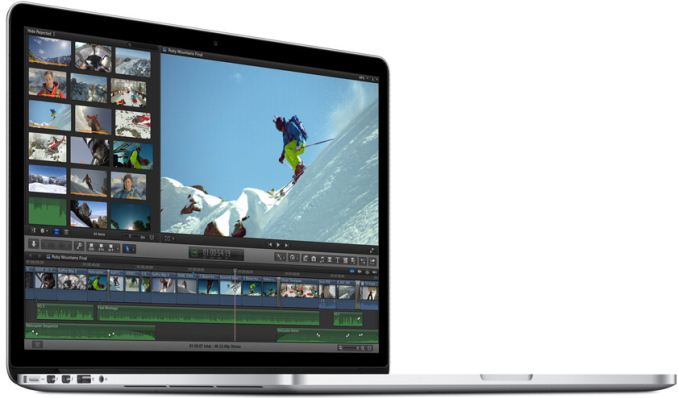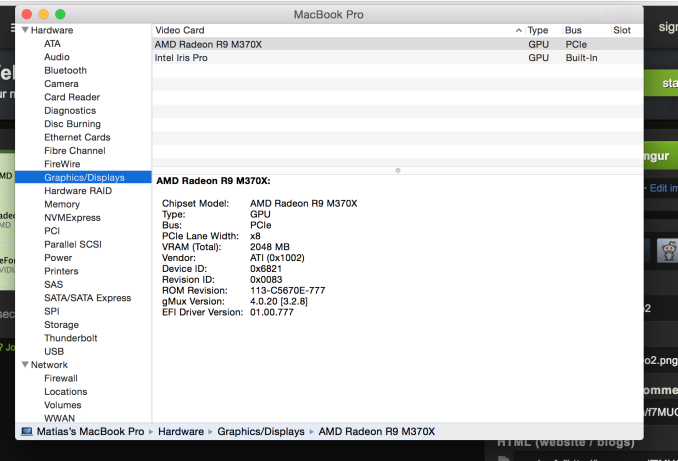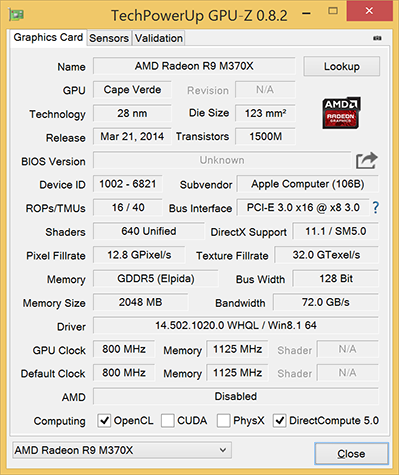2015 15-inch Retina MacBook Pro’s dGPU (R9 M370X) Is Cape Verde
by Ryan Smith on May 23, 2015 12:16 AM EST- Posted in
- GPUs
- Mac
- AMD
- Apple
- MacBook Pro
- Radeon
- Radeon 300

Earlier this week Apple announced their 2015 15” Retina MacBook Pro. Though Apple didn’t make any CPU changes, they did make some GPU changes on the high-end model, swapping out NVIDIA’s GeForce GT 750M for AMD’s Radeon R9 M370X. Since the M370X was not a published part number in AMD’s recently-announced 2015 Radeon M300 series refresh lineup, there have been some questions over just what M370X really is.
At the time of the rMBP’s launch, we suspected that it was an AMD Cape Verde GPU, based on the fact that this GPU is also in the M375, which is the next part above M370X. With the new laptop shipping immediately, M370X models have already begun arriving in buyers’ hands, finally giving us a chance to confirm the GPU inside.

Image courtesy Reddit user ootan
Thanks to Reddit user ootan, who posted a screenshot of the rMBP’s System Profiler, we can now confirm that the GPU in the rMBP is in fact AMD’s Cape Verde GPU. AMD has previously used the 6821 device ID on other mobile Cape Verde parts, so 6821 is already a known quantity.
| AMD M300 Series GPU Specification Comparison | |||||
| R9 M375 | R9 M370X (rMBP) | R7 M360 | |||
| Was | Variant of R9 M270/M260 | Variant of R9 M270X | Variant of R7 M270/M260 | ||
| Stream Processors | 640 | 640 | 384 | ||
| Texture Units | 40 | 40 | 24 | ||
| ROPs | 16 | 16 | 4? | ||
| Boost Clock | <=1015MHz | 800MHz | <=1015MHz | ||
| Memory Clock | 2.2GHz DDR3 | 4.5GHz GDDR5 | 2GHz DDR3 | ||
| Memory Bus Width | 128-bit | 128-bit | 64-bit | ||
| VRAM | <=4GB | 2GB | <=4GB | ||
| GPU | Cape Verde | Cape Verde | Oland/Topaz | ||
| Manufacturing Process | TSMC 28nm | TSMC 28nm | TSMC 28nm | ||
| Architecture | GCN 1.0 | GCN 1.0 | GCN 1.0 | ||
As for Cape Verde itself, as our regular readers may already know, it’s one of AMD’s first-generation GCN 1.0 GPUs, launched back in 2012. Compared to the GK107 GPU found in the GT 750M, it is a larger, more powerful (and at least in the desktop, more power-hungry) GPU, designed for more powerful devices than GK107 was. As for why Apple opted to switch now and to this GPU, we’ll leave that to Apple, AMD, and NVIDIA, though it’s by no means surprising that after having run GK107 for a couple of years, they would want to upgrade to a more powerful GPU.
Meanwhile, though we don’t have M370X on-hand at the moment, at least in the desktop, where GPU performance is unrestricted by thermals, Cape Verde fares very well. The rMBP on the other hand does have thermal constraints to deal with, so performance won’t be the same, but I expect it to fare reasonably well as well. Though at the same time I’m also curious if the use of a higher performance part has impacted the rMBP’s battery life when the dGPU is active; AMD and NVIDIA both do heavy binning, so a simple extrapolation won’t work here.
Update: And no sooner do I post this then someone sends me a screenshot of GPU-Z from a 15" rMBP running Boot Camp.
GPU-Z, for those unfamiliar with it, uses register poking to identify GPUs, so if the device ID wasn't enough, this settles it. This also confirms the clockspeeds - 800MHz core, 4.5GHz VRAM - and that the M370X is using GDDR5, unlike it's M375 counterpart. Thank you DMDrew812.
Source: Reddit User ootan (via SH SOTN)











107 Comments
View All Comments
darwinosx - Saturday, May 23, 2015 - link
Cheap and no support and runs Windows? No thanks.SpartanJet - Monday, May 25, 2015 - link
Running Windows is a huge plus over that mess of an OS.V900 - Saturday, May 23, 2015 - link
Thats hard to answer without knowing your exact use-case, and of course seeing some real world benchmarks.I'm definitely leaning towards the new model, since:
A: Despite a (possibly) worse GPU, the other improvements might make up for it. The harddisk is around twice as fast, since the PCI interface to the hard disk is twice as fast as in the old model.
B: A lot can be done in drivers and middleware to make up for a GPU that doesn't look very promising on paper. Parallels would certainly make up for at least some of its deficiencies in the next version, to make for better Windows performance than in Bootcamp.
C: And finally, if you really need the older model, but get the new one, it's a lot easier to sell it/swap it for an older one, than if you want the new one, but got the old one!
Solandri - Saturday, May 23, 2015 - link
Unless you're working with large files using large sequential reads and writes (e.g. real-time video editing), the performance for current SSDs is limited by the IOPS/4k read/write speeds, not by SATA3.The fact that these things are measured in MB/s is misleading. MB for MB, a jump from 25 MB/s to 50 MB/s 4k speeds will have 20x a greater impact on wait times than a jump from 500 MB/s to 1 GB/s sequential speeds.
So outside of specialized use cases, there's little benefit to going to PCIe. Instead, concentrate on finding a SSD with high IOPS. 4k writes seem to be ok with a few top SSDs managing to surpass 100 MB/s. But 4k reads still lag, peaking at about 40 MB/s. (I don't really criticize Apple for going with PCIe SSDs because a significant percentage of their customers do in fact use the MBPs for video editing. Just don't assume it means the drive is "twice as fast.")
testbug00 - Saturday, May 23, 2015 - link
Er, the newer GPU is most certainly faster. Apple claimed 80%, so, it's probably more realistically 40-50% in the real world.LukaP - Saturday, May 23, 2015 - link
The new one is still a decent laptop, and the Cape Verde GPU is not really power hungry at all, plus AMD can bin them to hell and back to get the nice ones, so dont worry too muchtestbug00 - Saturday, May 23, 2015 - link
If you don't game, the Nvidia model offers slightly better battery life.If you do game, the AMD model is significantly faster.
The AMD model can also driver higher resolution displays from the DP1.3 port.
repoman27 - Saturday, May 23, 2015 - link
Cape Verde, a GCN 1.0 part, combined with a DSL5520 Thunderbolt 2 controller... There's nothing that supports DisplayPort 1.3 here.You might be able to do 5120 x 2160 @ 60 Hz, 24 bpp, SST using a single DP 1.2 link, but that was apparently a typo on the spec page which Apple has corrected to read 5120 x 2880. Although they haven't yet updated their support page ( https://support.apple.com/en-us/HT202856 ) to include the new MacBook Pro (Retina, 15-inch, Mid 2015), the 5120 x 2880 @ 60 Hz resolution is almost assuredly achieved by using both Thunderbolt 2 ports and 2 cables.
Dug - Tuesday, May 26, 2015 - link
If you don't receive the latest version, Apple will exchange it for the latest version because you are within the window of announcement and availability.I can tell you almost every Macbook Pro with nvidia graphics has failed on us due to nvidia.
All of our other Mac's have been rock solid.
But take that with a grain of salt, as a lot of our users run Bootcamp. And as I understand it, the power and cooling is different which may have contributed to the problem. (Overheating, graphical glitches, and then failure)
darwinosx - Saturday, May 23, 2015 - link
Proving you know nothing about Apple fans.